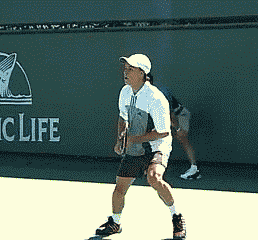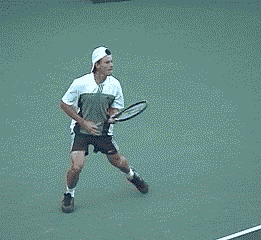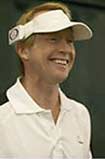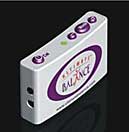|
TennisOne Lessons |
 Coria's backhand: open stance and very little upper-body motion. |
Most tennis instructors are adept at teaching the mechanical and mental approaches that make for a successful tennis player; however, there has been a lack of effective methods for teaching balance and footwork. Balance is largely the responsibility of the player, who must “feel” when his body is in balance and make the necessary corrections when it is not. It is up to tennis instructors to employ the drills and provide the feedback that will help their students develop this essential body sense.
Tennis in the Backcourt
In this installment, I examine balance in the backcourt. Tennis played at the baseline is all about power, fluid court movement, footwork and consistency. Balance is essential for each of these and, in the backcourt, is composed of two basic skills: rotation and recovery.
Argentinean Guillermo Coria is a great example of rotational power, fluid strokes, agile movement with seemingly little effort, and great balance and consistency. At 5'9” and 150 lbs, Coria's strokes are so spectacular, they took him to #3 in the world when many of his opponents were a half-foot taller and much more powerful physically.
Most of today's players are well over 6 feet tall and now, also use these types of balanced strokes and movements. With Roger Federer at 6'2”, Marat Safin at 6'4”, and Lindsay Davenport and Venus Williams well over 6 feet, these players are exploiting so much more of their physical potential that the game has advanced exponentially. These great athletes are the beacons for all of us who want to achieve our highest potential.
Backcourt Essentials
So what are the cornerstones of balanced movement in the backcourt: rotation and recovery?
Rotation
 Coria's forehand: rotation is the key to his power and quick recovery. |
Rotation initiated in the hips and trunk starts each stroke from the most powerful muscles in the body, allowing the shoulder and arm to swing more efficiently. The study of biomechanics has revealed that, in the most efficient movements, trunk rotation must lead upper body and arm movements. With rotation, the big muscles of the lower body do the work, so the arm can provide control, touch, and feel.
Rotation has other ramifications for the stroke as well. If a player's body doesn't rotate at the hips, power comes from his arm, which can result in elbow, shoulder, and wrist overuse injuries.
Leaning or being off-balance limits the ability to rotate because the twist involved forces the player to move even more off-balance. Being out of balance causes extra steps after the hit that slow recovery, another critical factor of successful backcourt tennis.
With rotation limited by leaning or being off-balance, a shorter hitting zone is available. Executed with proper rotation, a player's hitting zone can increase three to four times for one-handed forehands and two-handed backhands. This is due to the hip leading the arm, driving the body and racquet through the hitting zone, rather than wrapping the arms around a stationary trunk that pulls the racquet away from the path of the ball.
Extending the hitting zone is the basis for developing more consistency. To get the most power and consistency in his ground game, a player must rotate around a vertical spinal axis. The better the player's balance and the more vertical he is, the easier it is to rotate.
Poor recovery: the player needs to take extra steps after each hit. |
Recovery
The bane of many tennis players is being out of position after they hit a shot, either because they are watching the shot they just made or because they are thrown off-balance by hitting the ball. The first often begets the second. Recovery is the ability to hit a shot and prepare oneself for the next shot. To do this effectively, a player must have the proper footwork and remain in balance during and after the shot.
Unfortunately, many tennis players fall off-balance because their feet are not moving to begin with or because their feet get stuck as they try to stop and stabilize themselves in the middle of play. As beginners, players learn to hold their balance when they rotate and hit while standing still. As they move into real play and have to run and reach for shots, their footwork needs to become more dynamic.
When hitting on the run, a player must move his base of support beyond his center of gravity in order to create an immediate recovery movement. He can do this by pulling back toward the center with his upper body and kicking his feet out to brace his stop, similar to a skating or skiing stop. Without aligning his body in this way, his upper body momentum continues to make him either bend at the waist or fall off-balance beyond the shot when his feet stop.
Good recovery: the player is already recovering during the hit. |
In teaching students to “quiet” their upper body and keep their head still, instructors must also teach them to move their feet in a more dynamic way, constantly adjusting to keep the upper body firmly over their hips and feet. Developing the skill of dynamic footwork will help them recover more quickly for the next shot, as they don't have to fight their own momentum to go where they want to go.
In good baseline tennis, running long distances to hit shots is often necessary. Moving gracefully from forehand to backhand and recovering without taking unnecessary steps after the shot are the hallmarks of the great baseliners.
Baseline Balance Drills
Below are four drills that players can use to improve their balance at the baseline. These drills teach players to maintain their balance and recover for their next shot in the backcourt. These drills can be done both with and without the Ultimate Balance Trainer. The Ultimate Balance Trainer (www.ultimatebalance.com) helps tennis players improve their core balance and reach higher levels of performance through instant feedback during motion. This allows learning to occur through experience and repetition so the tennis instructor can focus on teaching strokes and strategy.
Drill #1 – Leading Rotation with the Hips
Problem: Do you use too much arm on your shot? Do your head, shoulders and arm often lean way forward of your hips, causing you to fall off-balance after hitting the ball? Do you lack power on your groundstrokes?
Drill 1: Rotation drill. Forehand. Click links to view the one-handed backhand drill and the two-handed backhand drill. |
Drill: Start in the ready position to hit a forehand, with your racquet back. As the ball comes into your hitting zone, bend your knees, keep your head over your hips and feet, and rotate your hips before your racquet moves. You will have to roll your back foot over as your hips rotate.
As your racquet swings, make sure you continue rotating your shoulders until your opposite arm is fully behind you, pointing at the back fence (your front elbow points toward your target). Hitting the ball in this way will give you a sense of your true power. Your vertical body and constant rotation keep your arm level and acceleration in control. If you are off-balance, you cannot fully rotate in this way. Then, try the same drill with your two-handed backhand.
Practice moving out wider for the ball, allowing your back toe to roll over and be dragged around as you fully rotate your hips and shoulders. Advanced players can then jump and use the hips rotating first to increase their power while maintaining perfect balance.
Drill #2 – Change the Recovery Loop
Problem: Do you stand and watch the shot you just hit instead of getting ready for your next shot? Do you allow yourself to fall off-balance when you hit, adding additional steps to your recovery?
|
Unconsciously, many players want to see the result of their efforts before they spend the energy to move back for the next shot. Or, with even a modicum of self-doubt, they stand and hope that their shot will go in, only to find that when the ball comes back over the net they are not ready and often terribly out of position.
Drill: This drill helps to change the process from “PPHR” (Perception -- Preparation --Hit --Recovery), which seems to be the logical sequence of events, to “PPRH” (Perception—Preparation--Recovery—Hit).
The basic premise of this drill is that the lower body must be in the process of recovery before the hit and continue to recover through the hit without stopping.
To work on this, the drill is done moving laterally along the baseline, hitting a wide forehand and then a wide backhand. When you get to the ball, pull your upper body back toward the center just before you hit. This pulls your slightly-leaning-forward body vertical at the contact point and slightly back toward the center of the court on the follow-through, creating better racquet acceleration, a consistent hitting position, and a fluid recovery with fewer struggles.
Drill #3 – All-Directional Recovery
This drill is designed for intermediate players.
Problem: Do you find that you only move and recover well in one or two directions? If so, you may be either a baseliner who moves well laterally or a net rusher who moves well in and out. This drill teaches players to move comfortably in every direction.
Drill: This drill is based on drill #2; however, you do it in all directions and recover to a circle at the center of the baseline. This helps you develop the muscle balance needed to feel confident on any shot hit at the baseline.
Drill 3: All-directional recovery drill: develops fluid hit-and-recovery motion for every baseline shot. (Click here to view - this is a large file and is best viewed using a broadband connection) |
Draw a chalk circle on the baseline to act as the recovery point for the student. The instructor feeds balls in a clockwise direction, drawing the student first straight in, then in on a 45-degree angle, then 90 degrees along the baseline, then back on a 45-degree angle for a lob back to the right, and so on, dialing the student around the circle in every direction.
At each ball, the student must begin his recovery before the hit and get back to the circle as quickly as possible. This drill builds confidence and helps the student feel as if he can move in a fluid manner for any shot.
Drill #4 – Kick Turn
This drill is designed for advanced players.
Problem: When you run at full speed across the backcourt to reach a ball, do you often stumble when you try to pull back? As in the other two recovery drills, this drill helps advanced players hit the ball already in recovery instead of falling past the ball and recovering late.
Drill 4: Kick-turn drill. |
Drill: To perform the kick turn, you must jump and project your lower body beyond your upper body toward the ball. By doing this, you can hit the ball with your upper body in a vertical position and allow your rotation to continue through the stroke, pulling your upper body even further back toward the center. That way, when you land to recover, your shoulders and upper body drive directly down into your feet, counteracting your lateral momentum.
While many tennis players do well as strict baseliners, those who can combine the power and consistency of backcourt play with the lethal gracefulness and agility of the volley game, like Roger Federer, can be even more successful. In the third and final installment of this series, I will address balance at the net, where quickness, accuracy and anticipation are the cornerstones of successful volleying.Your comments are welcome. Let us know what you think about Rhys Thomas' article by emailing us here at TennisOne.
![]()
The Ultimate Balance Trainer is now being used at many tennis facilities including Stan Smith's Smith-Stearns Tennis Academy as a teaching tool and at The Boston Athletic Club by Anne Smith as she trains to return to the Pro Tour. It will be shown at the PTR International Tennis Symposium February 23-24, 2005, where Rhys will be speaking about the essentials of teaching balance.
The Ultimate Balance Trainer can be purchased from the company's web site at www.ultimatebalance.com or from oncourt/offcourt. For additional information, please visit www.ultimatebalance.com or call 1-888-225-2620.
![]()
 Rhys Thomas
Rhys Thomas
Rhys Thomas is a 25-year USPTA professional, Black Belt in Tae Kwon Do, and a member of the National Head/Penn advisory staff.
He was instrumental in the development of the Ultimate Balance Trainer (www.ultimatebalance.com) as a balance-teaching tool for tennis professionals and other athletic coaches.
Rhys has been Director of Tennis at the Dedham Country and Polo Club in Dedham, Massachusetts, for the last 15 years.

